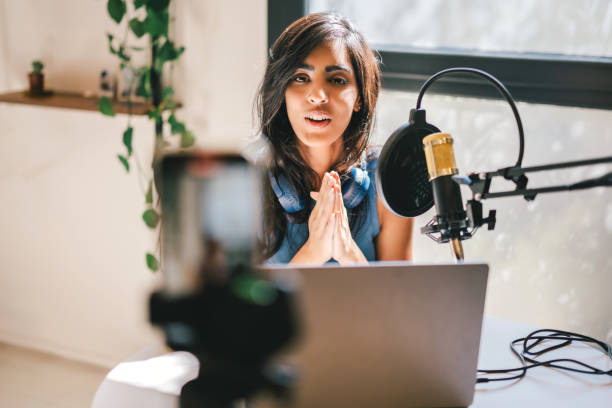It’s incredibly nerve-racking going on camera for the first time. Even if there is no one behind the camera, it’s still intimidating. It’s hard to be natural and be yourself when you know your every move is being recorded. However, this can be overcome.
Whether you’re a content creator, entrepreneur, or someone looking to boost your personal brand, having a strong on-camera presence is crucial in today’s digital world. Feeling confident and engaging on camera doesn’t always come naturally. With some practice, you can improve your on-camera skills and create videos that captivate your audience.
1. Prepare, but don’t over-script
One of the biggest mistakes people make is either over-preparing or not preparing enough. While it’s important to know your key points, over-scripting can make you sound robotic and less authentic. Instead, outline the main topics you want to cover and rehearse them until you feel comfortable.
Tips:
- Use bullet points instead of a word-for-word script to keep your speech natural.
- Practice in front of a mirror or record yourself to get familiar with your talking points.
- Focus on speaking naturally, as if you’re having a conversation with a friend.
2. Pay attention to your body language
Your body language speaks volumes. Even if your words are spot-on, poor body language can distract or disengage viewers. Aim to look open, approachable, and confident by paying attention to your posture, hand movements, and facial expressions.
Tips:
- Maintain eye contact with the camera as if it were a person.
- Use natural gestures to emphasise your points but avoid overdoing it.
- Smile genuinely; it makes you appear warm and approachable.
3. Work on your voice modulation
A monotonous voice can quickly lose your audience’s attention. To keep viewers engaged, vary your pitch, pace, and tone. Use pauses effectively to emphasise key points and to give your audience time to absorb your message.
Tips:
- Practice speaking with enthusiasm and energy, even if it feels exaggerated—it often translates well on camera.
- Record yourself and play it back to identify areas where your voice could use more variation.
- Use pauses to your advantage to create emphasis and allow your content to breathe.
4. Focus on lighting and camera setup
Your on-camera presence isn’t just about how you act; it’s also about how you look. Proper lighting and camera angles can significantly impact how you’re perceived. Good lighting can make you look more professional, while bad lighting can be distracting.
Tips:
- Position yourself facing a natural light source, like a window, or use softbox lights for a balanced look.
- Set your camera at eye level to maintain a natural and engaging perspective.
- Avoid cluttered backgrounds; keep your setup simple and relevant to your content.
5. Dress the part
What you wear on camera can affect your confidence and how your audience perceives you. Choose outfits that make you feel good, but also consider how colours and patterns appear on-screen.
Tips:
- Wear solid colours instead of busy patterns that can distract from your message.
- Avoid overly bright or reflective clothing that might interfere with lighting.
- Dress appropriately for your audience and the content of your video.
6. Practice good posture and breathing techniques
Good posture not only makes you look more confident, but it also helps with your breathing, which in turn improves your speech. Stand or sit up straight, keep your shoulders relaxed, and avoid slouching.
Tips:
- Practice diaphragmatic breathing (breathing from your belly) to help control your voice and reduce nerves.
- Take deep breaths before you start to calm any anxiety.
- Keep your feet flat on the ground if sitting to maintain stability and reduce fidgeting.
7. Connect with your audience emotionally
People connect with emotions, not just information. Show your personality, share stories, and let your audience see the real you. This authenticity helps build trust and keeps viewers coming back for more.
Tips:
- Don’t be afraid to show vulnerability or share personal anecdotes—it makes you relatable.
- Use facial expressions to match the tone of what you’re saying.
- Ask questions or encourage engagement to make your audience feel involved.
8. Get comfortable with silence and mistakes
Many people feel the need to fill every moment with talking, but this can lead to rushed or awkward content. Embrace pauses—they can make you appear more thoughtful and composed. Also, don’t stress over minor mistakes; they make you human.
Tips:
- Don’t be afraid to pause if you need to collect your thoughts—it’s better than rambling.
- If you make a mistake, keep going. Most viewers won’t notice, and those who do will appreciate your authenticity.
- Practice makes progress. The more you film, the more comfortable you’ll become with imperfections.
9. Seek feedback and continuously improve
The best way to improve is by seeking feedback. Ask trusted friends or followers for constructive criticism and take note of areas that need work.
Tips:
- Rewatch your videos critically, focusing on areas like pacing, tone, and body language.
- Ask for feedback specifically on your on-camera presence and how engaging you appear.
- Make small adjustments based on feedback, and keep practising—improvement is a continuous process.
Improving your on-camera presence is all about practice, preparation, and embracing your authentic self. By focusing on these tips and regularly reviewing your progress, you can create videos that not only inform, but also engage and connect with your audience. Remember, confidence comes with time, so keep showing up and refining your skills—you’ve got this!




